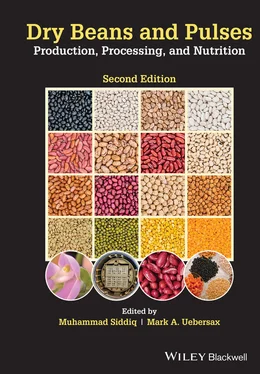Dry Beans and Pulses Production, Processing, and Nutrition
Здесь есть возможность читать онлайн «Dry Beans and Pulses Production, Processing, and Nutrition» — ознакомительный отрывок электронной книги совершенно бесплатно, а после прочтения отрывка купить полную версию. В некоторых случаях можно слушать аудио, скачать через торрент в формате fb2 и присутствует краткое содержание. Жанр: unrecognised, на английском языке. Описание произведения, (предисловие) а так же отзывы посетителей доступны на портале библиотеки ЛибКат.
- Название:Dry Beans and Pulses Production, Processing, and Nutrition
- Автор:
- Жанр:
- Год:неизвестен
- ISBN:нет данных
- Рейтинг книги:5 / 5. Голосов: 1
-
Избранное:Добавить в избранное
- Отзывы:
-
Ваша оценка:
- 100
- 1
- 2
- 3
- 4
- 5
Dry Beans and Pulses Production, Processing, and Nutrition: краткое содержание, описание и аннотация
Предлагаем к чтению аннотацию, описание, краткое содержание или предисловие (зависит от того, что написал сам автор книги «Dry Beans and Pulses Production, Processing, and Nutrition»). Если вы не нашли необходимую информацию о книге — напишите в комментариях, мы постараемся отыскать её.
The second edition of the most complete and authoritative reference on dry beans production, processing, and nutrition available Dry Beans and Pulses: Production, Processing, and Nutrition
Dry Beans and Pulses: Production, Processing, and Nutrition, Second Edition
Dry Beans and Pulses Production, Processing, and Nutrition — читать онлайн ознакомительный отрывок
Ниже представлен текст книги, разбитый по страницам. Система сохранения места последней прочитанной страницы, позволяет с удобством читать онлайн бесплатно книгу «Dry Beans and Pulses Production, Processing, and Nutrition», без необходимости каждый раз заново искать на чём Вы остановились. Поставьте закладку, и сможете в любой момент перейти на страницу, на которой закончили чтение.
Интервал:
Закладка:
Within dry beans, the small‐ and medium‐seeded markets – including black, navy, pinto, great northern, pink, and small red beans – belong in the MA gene pool. The large‐seeded kidney, cranberry, and yellow beans are Andean in origin. These gene pools are so distinct that in crosses they produce semi‐lethal progeny, suggesting a genetic separation equivalent to subspecies classification. Dwarf lethal DL 1genes found in the root of MA beans are not compatible with the DL 2gene functional in the shoots of Andean germplasm. Crosses between gene pools produce a weak semi‐lethal F 1intergene pool hybrid that severely restricts free gene exchange (Hannah et al. 2007). Breeders have successfully transferred single genes between gene pools, and the beneficial genetic contrast between gene pools has been a useful strategy in controlling pathogens adapted to a specific gene pool (Kelly and Miklas 1998). The greatest challenge for breeders is to use the diversity in one gene pool to enhance the other (Singh 1995). This has proved difficult for complex traits due to a lack of recombination between the gene pools (Kornegay et al. 1992).
Attempting to transfer yield potential from black beans to enhance yield of kidney beans was met with limited success, as a determining factor in bean breeding is seed size that corresponds with market class (Kelly et al. 1998). Kidney beans with one of the largest seed sizes (60g/100 seed) are generally lower yielding than small‐seeded black beans (20 g/100 seeds). In addition to genetic differences, each gene pool utilizes different physiological mechanisms to produce yield. Adams (1967) demonstrated the concept of yield component compensation in dry beans, where gain in one yield component was generally reflected by losses in another. Thus, selection for large seed size will result in either fewer pods per plant or fewer seeds per pod, either of which contributes to less yield. Limited genomic recombination is another factor limiting the exchange of genetic diversity between the gene pools. Segregation distortion is common in inter‐gene pool crosses (Blair et al. 2003) and the existence of incompatibility genes that result in gamete elimination in the species have also been suggested (Checa and Blair 2008). As a result of these gene pool incompatibilities, little progress has been made in the breeding of Andean type beans. Only modest gains in performance have been reported over years of breeding kidney and cranberry bean classes in the US. This lack of success has resulted in decreased acreage being planted to kidney and cranberry beans in the US. Likewise, the dominant bean class in Brazil is the MA carioca bean that was introduced in the late 1940s and has replaced the traditional large‐seeded Andean Jalo seed types. There is some optimism that new molecular tools and technologies might provide opportunities to correct this limitation in breeding Andean beans. Expanded crossing with landraces within the gene pools is a recommended strategy (Gioia et al. 2019) to increase genetic diversity that is being implemented (Cichy et al. 2015) for Andean beans. An alternative approach is to use the wild species with its “hidden” genetic potential rather than trying to focus on recombination within or between species where these gene pool incompatibilities exist.
Wild bean germplasm
It is well recognized that during crop domestication, only a portion of the wild germplasm is domesticated, and these events are known as the founder effect. Wild germplasm is recognized as being more diverse and a potential source for valuable traits absent from the cultivated species. The best example of this are the accessions of wild P. vulgaris from Arcelia, Mexico shown to possess a unique protein trait that conditions insecticidal activities not found in the cultivated species (Cardona et al. 1989). The lectin‐like protein known as Arcelin provides resistance to the Mexican bean beetle ( Zabrotes subfasciatus ), which is a serious storage pest of bean seed. Since beans are cooked prior to consumption, the protein is denatured and has no negative effects on humans. The most effective Arc ‐genes have been successfully backcrossed into cultivated bean varieties and are being deployed in many developing countries where the pest occurs (Kusolwa et al. 2016). Access to wild species of P. vulgaris is actually within easy reach of most breeding programs. Koinange et al. (1996) described the domestication syndrome in common bean and showed that many of the major genetic changes between wild and cultivated are controlled by relatively few loci. For example, changes in photoperiod sensitivity, growth habit, seed size, and pod shattering are under major gene control that reside on a relatively few chromosomes. As a result, breeders can recover cultivated plant and seed types in a few backcrosses to the cultivated parent after making the original cross with the wild species (Kelly 2004; Acosta et al. 2007). Unlike challenges in crossing between species, no special techniques are required to cross between wild and cultivated accessions of P. vulgaris . The inbred backcross method (described later in the chapter) has facilitated crossing between wild and cultivated accessions (Blair et al. 2006). The biggest obstacle to utilizing wild species is in the identification and selection of the actual wild accession used in crossing. Berny Mier y Teran et al. (2019) identified wild germplasm from different ecological zones with adaptation to intermittent drought and used them in nested recombinant inbred populations (Berny Mier y Teran et al. 2020) to move drought tolerance from wild to cultivated dry bean. Currently there are approximately 240 wild accessions of P. vulgaris in the US germplasm bank, and unless breeders attempt to utilize these materials in future breeding efforts valuable traits present in this germplasm may never be exploited.
BREEDING PROCEDURES AND PRACTICES
Breeding procedures − hybridization
Most breeding programs follow a similar procedure, with major variations to the procedure (described below) occurring during the selection process in later generations of inbreeding. The process starts with the need to introduce new traits through manual cross pollination. Most breeders in North America make crosses in the greenhouse during the winter season while breeders in the tropics make crosses in the field. Beans are manually cross pollinated in the bud stage before the flowers open ( Figure 2.4 ). Once a flower is fully open, it has already been self‐pollinated. The flower structure consists of a central female style that ends in a stigma, which is coiled and surrounded by a filament that consists of 10 stamens, which suspend the anthers that contain the pollen. Detailed drawings of dissected bean flowers are illustrated in Freytag and Debouck (2002). In the past, breeders would open the immature bud and physically remove a portion of the filament with all 10 anthers. Since the stigma is receptive before the pollen is released from the anthers, the breeder then transfers pollen from male parent to that receptive stigma. Pollen is transferred by breaking off the pollinated stigma (carries excess pollen) from the male donor and hooking that excised stigma with the receptive stigma of the female parent. The flower bud is closed and tagged to indicate the pollen donor. This entire process severely damages the flower, resulting in a low success rate (<50%) with few hybrid seeds produced per pod. Forage legume flowers such as clovers and alfalfa have a natural tripping mechanism to facilitate outcrossing by insects. Beans have a similar mechanism, which breeders manipulate to trip flower buds by depressing downward on the base of two petals to force the stigma out of the filament and away from the immature anthers. At this point, pollen using excised stigma from male parent can be transferred to the tripped stigma with minimum damage resulting in a significantly higher success rate (>90%), with more hybrid seeds in the pod. Since developing hybrid pods are less competitive in development to normally self‐ pollinated pods, many of the latter are removed from the female parent by breeders to favor the production of F 1hybrid seed. Breeders mostly work with populations developed from a single cross of two parents, but in some instances, crosses between F 1hybrids are used to produce a four‐way cross as a means of introducing more traits into the progeny, from four parents rather than two.
Читать дальшеИнтервал:
Закладка:
Похожие книги на «Dry Beans and Pulses Production, Processing, and Nutrition»
Представляем Вашему вниманию похожие книги на «Dry Beans and Pulses Production, Processing, and Nutrition» списком для выбора. Мы отобрали схожую по названию и смыслу литературу в надежде предоставить читателям больше вариантов отыскать новые, интересные, ещё непрочитанные произведения.
Обсуждение, отзывы о книге «Dry Beans and Pulses Production, Processing, and Nutrition» и просто собственные мнения читателей. Оставьте ваши комментарии, напишите, что Вы думаете о произведении, его смысле или главных героях. Укажите что конкретно понравилось, а что нет, и почему Вы так считаете.












